If you train in a commercial or well-equipped garage gym, you probably have access to dozens if not hundreds of different exercises that you can use to sculpt the body of your dreams. For back workouts, that means things like lat pulldowns, pull-ups, chin-ups, machine pullovers, and seated rows are staples of your training. You might also include things like single-arm rows and Kroc rows in your back workouts for even more variety.
But, what if you train at home and your “gym” is nothing more than a barbell, some weights, and an adjustable exercise bench? Can you REALLY train your back with such a limited selection of training equipment?
Before commercial gyms became commonplace, bodybuilders and strength athletes worked out with a sparse selection of training equipment. Many made do with just a few dumbbells and a barbell.
And yet, despite this low-tech approach to training, those lifters of yesteryear still managed to build amazing bodies and impressive levels of strength.
Don’t let lack of equipment lead you to think that you can’t get excellent results from your workouts. You can achieve your training goals using just a barbell.
In this article, we reveal the best barbell back exercises for home training, but, of course, you can also do these exercises in a gym.
Basic Back Anatomy
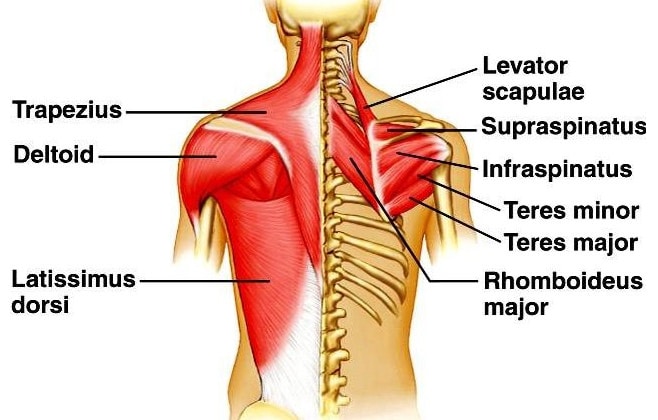 Back Anatomy Muscles
Back Anatomy Muscles
Your back is a large group of muscles. If you want to build a strong, muscular back, you need to pay attention to all of these muscles. The main muscles that make up your back are:
Latissimus dorsi – this is the largest of your upper back muscles. Known as your lats for short, when well developed, they look not unlike a pair of wings. Located on the side of your upper back, the lats adduct and extend your shoulders.
Trapezius – the traps are a large diamond-shaped muscle that covers your upper back. There are three sets of fibers, and each one has a different function. The upper traps elevate your shoulder girdle, the middle traps pull your shoulders back and together, and the lower traps depress your shoulder girdle.
Rhomboids – this small muscle is located between your shoulder blades. The rhomboids work with your mid traps to retract your shoulder girdle and are also involved in shoulder elevation.
Posterior deltoids – while not strictly a back muscle, the posterior deltoids are on the rear of your body and are involved in most barbell back exercises. The deltoids are your shoulder muscles, and the posterior delts work with your lats to extend your shoulders.
Erector spinae – this is the collective name for the muscles that run up either side of your spine. They extend your spine and prevent it from rounding during exercises like deadlifts and bent-over rows.
The Best Barbell Back Exercises
Build muscle size, strength, and power by adding these barbell exercises to your home back workouts!
1. Bent-over Barbell Row
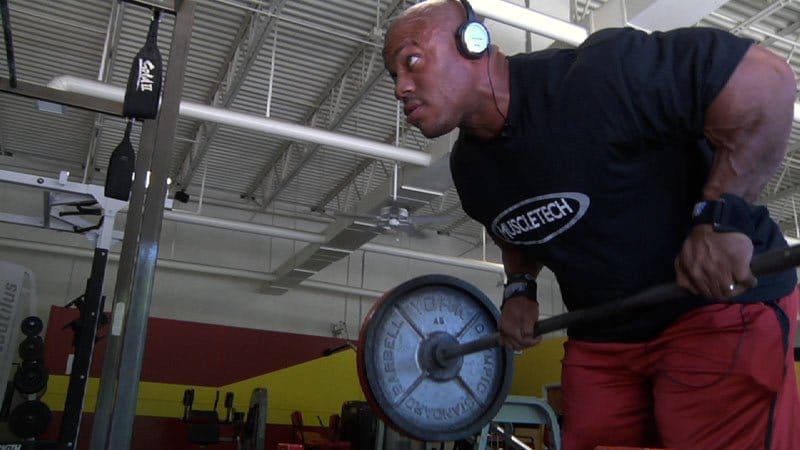

The bent-over barbell row works your entire back, from top-to-bottom and side-to-side. It also provides your biceps with a beneficial workout. Using a barbell means you can use an underhand or an overhand grip as preferred.
Use a wide grip and pull the bar into your chest to emphasize your mid-traps, rhomboids, and posterior deltoids. Use a narrower grip and pull the bar into your abdomen to work your lats more.
Learn how to do bent-over barbell rows here.
2. Pendlay Row
Pendlay rows are named after American Olympic lifting and powerlifting coach Glen Pendlay. Unlike most barbell back exercises, every rep of Pendlay rows starts with the weight resting on the floor. That’s why this exercise is sometimes called the dead-stop row.
Starting from a dead stop eliminates momentum, means you have to be more explosive at the beginning of each rep, and also provides your lower back and grip with a brief rest between reps. Because of this, you may be able to lift more weight or do more reps than with conventional bent-over rows.
Find out more about this classic barbell back builder in our in-depth guide.
3. Barbell T-bar Row
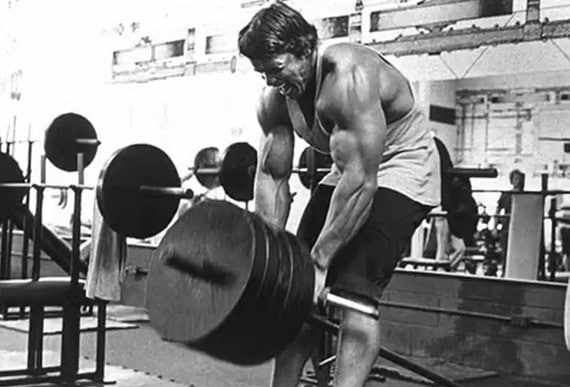 T-Bar Row
T-Bar Row
Most gyms have a T-bar row machine, but you can also do this exercise at home using just a barbell.
How to do it:
[*]Put one end of your barbell in a corner so it won’t move. Load the other end with the required amount of weight. Stand astride the bar with your feet about shoulder-width apart.
[*]Reach down and hold the bar just behind the weight plates. Place your hands close together or interlace your fingers as preferred. Brace your abs, straighten your arms, and lift the weights a few inches off the ground. Your torso should be inclined to about 45-degrees.
[*]Bend your arms and row the bar up as far as you can. Keep your upper arms close to your sides. Pull your shoulders down and back.
[*]Extend your arms and repeat.
[*]Take care not to round your lower back, as doing so could lead to back pain and injury.
Read more about T-bar rows here.
4. Single-arm T-bar Row
This barbell back exercise is unusual because it allows you to train one side of your back at a time. Do this move in place of single-arm dumbbell rows when you just have a barbell to train with.
Perform as above (#3) but stand side-on to your bar instead of astride it. Use the arm nearest to the bar. Make sure you do the same number of reps with each arm.
5. Yates Row
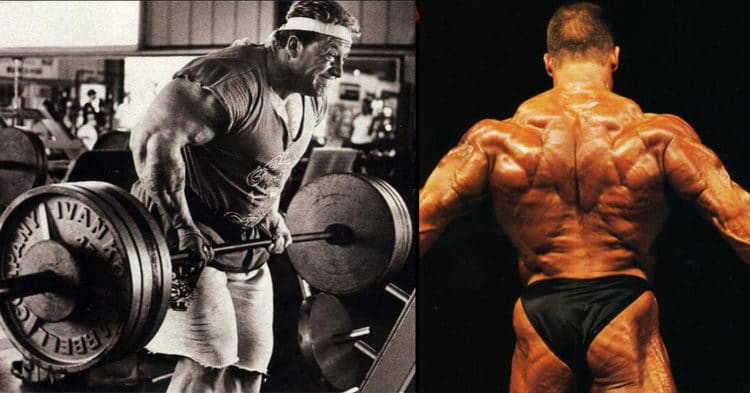 Yates Row
Yates Row
Dorian Yates is a bodybuilding legend and had one of the most perfectly developed backs in history. Winner of six Mr. Olympia titles, Yates had an unusual way of doing bent-over barbell rows. Instead of leaning over all the way, he used a much shallower torso angle.
This, he believed, meant less lower back strain and better overall back development. This exercise definitely worked for Dorian Yates, and it may work for you, too.
Find out how to do the Yates row in our detailed guide.
6. Meadows Row
John Meadows, also known as the Mountain Dog, is a professional bodybuilder and coach. This unique barbell back exercise is his invention. It works your back from an unusual angle, which could be just what you need to build your best back ever.
How to do it:
[*]Put one end of your barbell in a corner so it won’t move. Load the other end with the required amount of weight. Stand perpendicular to the end of the bar.
[*]Bend forward and, without rounding your lower back, grab the end of the bar with an overhand grip. Brace your abs. Place your non-working arm on your nearside leg for support.
[*]Without rounding your lower back, bend your arm and pull the weight up and into the side of your ribs. Extend your arm and repeat.
[*]Do the same number of reps on each side.
7. Chest Supported Row
Most barbell back exercises work your upper AND lower back at the same time. This one is different in that it removes your lower back from your workout and allows you to focus more on your lats, traps, and rhomboids. It’s lower-back friendly so it’s useful if you have a sore, tired, or injured lower back.
How to do it:
[*]Set the backrest on an adjustable bench to around 30 to 45-degrees. Place your barbell on the floor beneath the bench.
[*]Lie face down on your bench with your head uppermost. Reach down and hold the bar with a narrow underhand or wider overhand grip. Pull your shoulders down and back.
[*]Bend your arms and pull the bar up until it lightly touches the underside of the bench. Lead with your elbows and keep your wrists straight.
[*]Extend your arms and repeat.
8. Deadlift
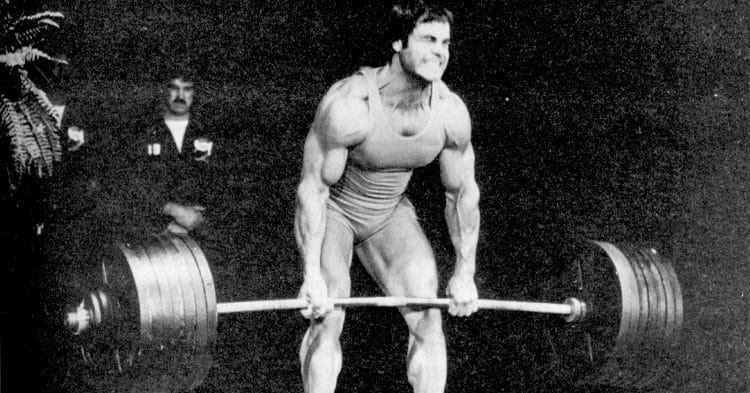 Deadlifts
Deadlifts
Deadlifts work your entire back. Many people think deadlifts are a leg exercise, and while they undoubtedly do involve your lower body, they’re an equally good back builder.
You need to use your mid-traps and rhomboids to pull your shoulders back, your upper traps to stop your shoulders from being pulled downward, and your lats to keep the bar close to your legs. Your erector spinae work to extend your spine and stop it rounding.
If you are ever forced to choose just one barbell back exercise, the barbell deadlift should probably be it.
Learn how to do deadlifts here.
9. Romanian Deadlift
Legend has it that Romanian deadlifts are so-called because American weightlifting coaches learned it from Romanian Olympic lifters. While this may or may not be true, the Romanian deadlift is an excellent lower back exercise that also works your mid-traps, rhomboids, and upper traps. Romanian deadlifts are also a superb glute and hamstring exercise.
Read this guide to find out how to do Romanian deadlifts correctly.
10. Good Morning
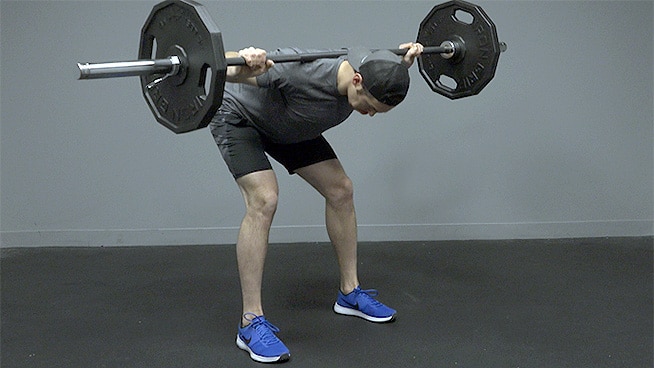 Good Morning
Good Morning
Good-mornings are a lot like Romanian deadlifts but, instead of holding the barbell in your hands, you rest it across your upper back, like you’re doing squats. This exercise is so-called because it looks like you are bowing in greeting, and works your erector spinae from the bottom of your spine to the base of your skull.
The good-morning is a slightly controversial exercise because it has a reputation for being hard on your lower back. However, done correctly and without rounding, it’s no riskier than any other exercise that involves leaning forward.
Read our guide to doing good mornings here.
Home Barbell Back Workout
Not sure where to start with your home barbell back workout? No problem, we’ve got you covered. To save you from designing your own plan, do the following training program 1-2 times per week. If you do it twice, make sure you allow a few days for recovery and muscle growth, e.g., Monday and Thursday.
Before you start working out, remember to warm up. A thorough warm-up will reduce your risk of injury and increase the effectiveness of your workout.
Jog or jump rope for 5-10 minutes and then do a few joint mobility and dynamic flexibility exercises for the body parts you are about to train. Pay extra attention to your lower back. Finish your warm-up with a few light sets of the first 1-2 exercises of the workout.
Note: Adjust the reps to match your training goal.
For strength – 3-5 reps using 85% or more of your 1-repetition maximum (3-5 minutes rest between sets)
For muscle size – 6-12 reps using 67-85% of your 1-RM (1-2 minutes rest between sets)
For muscular endurance – 13-20 reps using 50-67% of your 1RM (30-60 seconds rest between sets)
#
Exercise
1
Deadlifts
2
Single-arm T-bar row
3
Yates row
4
Romanian deadlifts
Wrapping Up
A lot of people think that to build muscle strength and size, you need access to a vast array of training equipment. They believe that, without things like machines, power racks, cables, bands, and chains, whatever they do won’t be productive.
This simply is not true!
Your body is amazing and consists of over 600 muscles, 206 bones, dozens of organs, and miles of blood vessels and nerves. But, despite this complexity, it has a hard time differentiating between using a top-of-the-range seated row machine in a state-of-the-art gym and doing T-bar rows with a rusty old barbell at home. All it really knows is weight, work, and tension.
Providing you work hard and consistently enough, you can use almost anything to build muscle and strength. So, don’t feel disheartened because you’ve only got a barbell to use for your back workouts. In reality, that is all you need to build the body of your dreams!
Click here to view the article.
But, what if you train at home and your “gym” is nothing more than a barbell, some weights, and an adjustable exercise bench? Can you REALLY train your back with such a limited selection of training equipment?
Before commercial gyms became commonplace, bodybuilders and strength athletes worked out with a sparse selection of training equipment. Many made do with just a few dumbbells and a barbell.
And yet, despite this low-tech approach to training, those lifters of yesteryear still managed to build amazing bodies and impressive levels of strength.
Don’t let lack of equipment lead you to think that you can’t get excellent results from your workouts. You can achieve your training goals using just a barbell.
In this article, we reveal the best barbell back exercises for home training, but, of course, you can also do these exercises in a gym.
Basic Back Anatomy

Your back is a large group of muscles. If you want to build a strong, muscular back, you need to pay attention to all of these muscles. The main muscles that make up your back are:
Latissimus dorsi – this is the largest of your upper back muscles. Known as your lats for short, when well developed, they look not unlike a pair of wings. Located on the side of your upper back, the lats adduct and extend your shoulders.
Trapezius – the traps are a large diamond-shaped muscle that covers your upper back. There are three sets of fibers, and each one has a different function. The upper traps elevate your shoulder girdle, the middle traps pull your shoulders back and together, and the lower traps depress your shoulder girdle.
Rhomboids – this small muscle is located between your shoulder blades. The rhomboids work with your mid traps to retract your shoulder girdle and are also involved in shoulder elevation.
Posterior deltoids – while not strictly a back muscle, the posterior deltoids are on the rear of your body and are involved in most barbell back exercises. The deltoids are your shoulder muscles, and the posterior delts work with your lats to extend your shoulders.
Erector spinae – this is the collective name for the muscles that run up either side of your spine. They extend your spine and prevent it from rounding during exercises like deadlifts and bent-over rows.
The Best Barbell Back Exercises
Build muscle size, strength, and power by adding these barbell exercises to your home back workouts!
1. Bent-over Barbell Row


The bent-over barbell row works your entire back, from top-to-bottom and side-to-side. It also provides your biceps with a beneficial workout. Using a barbell means you can use an underhand or an overhand grip as preferred.
Use a wide grip and pull the bar into your chest to emphasize your mid-traps, rhomboids, and posterior deltoids. Use a narrower grip and pull the bar into your abdomen to work your lats more.
Learn how to do bent-over barbell rows here.
2. Pendlay Row
Pendlay rows are named after American Olympic lifting and powerlifting coach Glen Pendlay. Unlike most barbell back exercises, every rep of Pendlay rows starts with the weight resting on the floor. That’s why this exercise is sometimes called the dead-stop row.
Starting from a dead stop eliminates momentum, means you have to be more explosive at the beginning of each rep, and also provides your lower back and grip with a brief rest between reps. Because of this, you may be able to lift more weight or do more reps than with conventional bent-over rows.
Find out more about this classic barbell back builder in our in-depth guide.
3. Barbell T-bar Row

Most gyms have a T-bar row machine, but you can also do this exercise at home using just a barbell.
How to do it:
[*]Put one end of your barbell in a corner so it won’t move. Load the other end with the required amount of weight. Stand astride the bar with your feet about shoulder-width apart.
[*]Reach down and hold the bar just behind the weight plates. Place your hands close together or interlace your fingers as preferred. Brace your abs, straighten your arms, and lift the weights a few inches off the ground. Your torso should be inclined to about 45-degrees.
[*]Bend your arms and row the bar up as far as you can. Keep your upper arms close to your sides. Pull your shoulders down and back.
[*]Extend your arms and repeat.
[*]Take care not to round your lower back, as doing so could lead to back pain and injury.
Read more about T-bar rows here.
4. Single-arm T-bar Row
This barbell back exercise is unusual because it allows you to train one side of your back at a time. Do this move in place of single-arm dumbbell rows when you just have a barbell to train with.
Perform as above (#3) but stand side-on to your bar instead of astride it. Use the arm nearest to the bar. Make sure you do the same number of reps with each arm.
5. Yates Row

Dorian Yates is a bodybuilding legend and had one of the most perfectly developed backs in history. Winner of six Mr. Olympia titles, Yates had an unusual way of doing bent-over barbell rows. Instead of leaning over all the way, he used a much shallower torso angle.
This, he believed, meant less lower back strain and better overall back development. This exercise definitely worked for Dorian Yates, and it may work for you, too.
Find out how to do the Yates row in our detailed guide.
6. Meadows Row
John Meadows, also known as the Mountain Dog, is a professional bodybuilder and coach. This unique barbell back exercise is his invention. It works your back from an unusual angle, which could be just what you need to build your best back ever.
How to do it:
[*]Put one end of your barbell in a corner so it won’t move. Load the other end with the required amount of weight. Stand perpendicular to the end of the bar.
[*]Bend forward and, without rounding your lower back, grab the end of the bar with an overhand grip. Brace your abs. Place your non-working arm on your nearside leg for support.
[*]Without rounding your lower back, bend your arm and pull the weight up and into the side of your ribs. Extend your arm and repeat.
[*]Do the same number of reps on each side.
7. Chest Supported Row
Most barbell back exercises work your upper AND lower back at the same time. This one is different in that it removes your lower back from your workout and allows you to focus more on your lats, traps, and rhomboids. It’s lower-back friendly so it’s useful if you have a sore, tired, or injured lower back.
How to do it:
[*]Set the backrest on an adjustable bench to around 30 to 45-degrees. Place your barbell on the floor beneath the bench.
[*]Lie face down on your bench with your head uppermost. Reach down and hold the bar with a narrow underhand or wider overhand grip. Pull your shoulders down and back.
[*]Bend your arms and pull the bar up until it lightly touches the underside of the bench. Lead with your elbows and keep your wrists straight.
[*]Extend your arms and repeat.
8. Deadlift

Deadlifts work your entire back. Many people think deadlifts are a leg exercise, and while they undoubtedly do involve your lower body, they’re an equally good back builder.
You need to use your mid-traps and rhomboids to pull your shoulders back, your upper traps to stop your shoulders from being pulled downward, and your lats to keep the bar close to your legs. Your erector spinae work to extend your spine and stop it rounding.
If you are ever forced to choose just one barbell back exercise, the barbell deadlift should probably be it.
Learn how to do deadlifts here.
9. Romanian Deadlift
Legend has it that Romanian deadlifts are so-called because American weightlifting coaches learned it from Romanian Olympic lifters. While this may or may not be true, the Romanian deadlift is an excellent lower back exercise that also works your mid-traps, rhomboids, and upper traps. Romanian deadlifts are also a superb glute and hamstring exercise.
Read this guide to find out how to do Romanian deadlifts correctly.
10. Good Morning

Good-mornings are a lot like Romanian deadlifts but, instead of holding the barbell in your hands, you rest it across your upper back, like you’re doing squats. This exercise is so-called because it looks like you are bowing in greeting, and works your erector spinae from the bottom of your spine to the base of your skull.
The good-morning is a slightly controversial exercise because it has a reputation for being hard on your lower back. However, done correctly and without rounding, it’s no riskier than any other exercise that involves leaning forward.
Read our guide to doing good mornings here.
Home Barbell Back Workout
Not sure where to start with your home barbell back workout? No problem, we’ve got you covered. To save you from designing your own plan, do the following training program 1-2 times per week. If you do it twice, make sure you allow a few days for recovery and muscle growth, e.g., Monday and Thursday.
Before you start working out, remember to warm up. A thorough warm-up will reduce your risk of injury and increase the effectiveness of your workout.
Jog or jump rope for 5-10 minutes and then do a few joint mobility and dynamic flexibility exercises for the body parts you are about to train. Pay extra attention to your lower back. Finish your warm-up with a few light sets of the first 1-2 exercises of the workout.
Note: Adjust the reps to match your training goal.
For strength – 3-5 reps using 85% or more of your 1-repetition maximum (3-5 minutes rest between sets)
For muscle size – 6-12 reps using 67-85% of your 1-RM (1-2 minutes rest between sets)
For muscular endurance – 13-20 reps using 50-67% of your 1RM (30-60 seconds rest between sets)
#
Exercise
1
Deadlifts
2
Single-arm T-bar row
3
Yates row
4
Romanian deadlifts
Wrapping Up
A lot of people think that to build muscle strength and size, you need access to a vast array of training equipment. They believe that, without things like machines, power racks, cables, bands, and chains, whatever they do won’t be productive.
This simply is not true!
Your body is amazing and consists of over 600 muscles, 206 bones, dozens of organs, and miles of blood vessels and nerves. But, despite this complexity, it has a hard time differentiating between using a top-of-the-range seated row machine in a state-of-the-art gym and doing T-bar rows with a rusty old barbell at home. All it really knows is weight, work, and tension.
Providing you work hard and consistently enough, you can use almost anything to build muscle and strength. So, don’t feel disheartened because you’ve only got a barbell to use for your back workouts. In reality, that is all you need to build the body of your dreams!
Click here to view the article.

